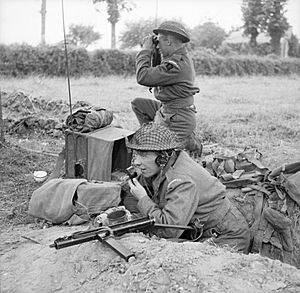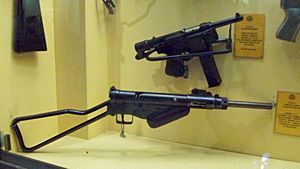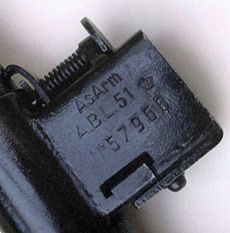Sten facts for kids
Quick facts for kids Sten submachine gun |
|
|---|---|
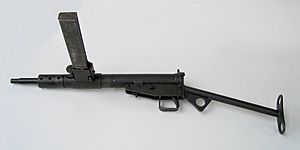
A Sten MK II
|
|
| Type | Submachine gun |
| Place of origin | United Kingdom |
| Service history | |
| In service | 1941–1960s (United Kingdom) 1941–present (Other countries) |
| Used by | See Users |
| Wars | World War II Second Sino-Japanese War Chinese Civil War Indonesian National Revolution First Indochina War Indo-Pakistan Wars 1948 Arab–Israeli War Malayan Emergency Korean War Mau Mau Uprising Algerian War Suez Crisis Sino-Indian War Vietnam War Indonesia–Malaysia confrontation Laotian Civil War Biafran War Bangladesh Liberation War Lebanese Civil War Angolan Civil War Rhodesian Bush War Turkish invasion of Cyprus IRA Border Campaign The Troubles Punjab insurgency Maluku sectarian conflict Iraq War Syrian Civil War |
| Production history | |
| Designer | Major Reginald V. Shepherd Harold J. Turpin |
| Designed | 1940 |
| Manufacturer | Royal Small Arms Factory Enfield BSA ROF Fazakerley ROF Maltby ROF Theale Berkshire Lines Brothers Ltd< Long Branch Arsenal, Canada Various underground resistance group factories |
| Unit cost | £2 6s in 1942 |
| Produced | 1941– (version dependent) |
| No. built | 3.7–4.6 million (all variants, depending on source) |
| Variants | Mk. I, II, IIS, III, IV, V, VI |
| Specifications | |
| Mass | 3.2 kg (7.1 lb) (Mk. II) |
| Length | 762 mm (30.0 in) |
| Barrel length | 196 mm (7.7 in) |
|
|
|
| Cartridge | 9×19mm Parabellum |
| Action | Blowback-operated, open bolt |
| Rate of fire | version dependent; ~500–600 round/min |
| Muzzle velocity | 365 m/s (1,198 ft/s) 305 m/s (1,001 ft/s) (suppressed models) |
| Effective firing range | 100 m |
| Feed system | 32-round detachable box magazine |
| Sights | fixed peep rear, post front |
The Sten (or Sten gun) is a British submachine gun. It uses 9mm bullets. British and Commonwealth soldiers used it a lot during World War II and later, including the Korean War. The Sten was designed to be very simple and cheap to make. This allowed many of them to be produced quickly.
Besides regular soldiers, the Sten was also given to resistance groups in countries taken over by enemies. Its simple design made it a good weapon for these groups.
The Sten is a special kind of gun that can fire single shots or many shots very fast. Its magazine, which holds the bullets, sticks out from the left side. The name "Sten" comes from the names of its main designers, Major Reginald V. Shepherd and Harold J. Turpin. The "En" stands for the Enfield factory where it was made. About four million Stens were made in the 1940s. This made it the second most produced submachine gun of World War II. The Sten later led to the design of the Sterling submachine gun, which replaced it in British service.
Contents
The Sten Gun: A Wartime Hero
Why the Sten Was Made
The Sten gun was created during the Battle of Britain. At this time, Britain was fighting against Nazi Germany and feared an invasion. The British army needed to replace many weapons lost during the Dunkirk evacuation. They also needed more weapons as their army grew.
Britain bought many Thompson submachine guns from the United States. But these guns were expensive and there weren't enough of them. A Thompson cost $200 in 1939, while a Sten cost only $11. When America joined the war in late 1941, there was even more demand for Thompsons. To quickly arm its soldiers, the Royal Small Arms Factory in Enfield, England, was asked to make a new, cheaper gun.
The main designers were Major R. V. Shepherd and Harold John Turpin. Shepherd was an inspector in the Ministry of Supply. Turpin was a senior designer at the Enfield factory.
How the Sten Was Designed
The Sten shared some ideas with the Lanchester submachine gun. The Lanchester was being made for the Royal Navy and Air Force. It was a copy of a German gun called the MP28. Both the Lanchester and Sten had magazines that stuck out from the side. Interestingly, their magazines could even be swapped.
However, the Lanchester was made with high-quality materials and looked very fancy. The Sten was the opposite. It used simple stamped metal parts and only a little welding. This meant it needed very little special machinery to make. Small workshops could make many of its parts. The guns were then put together at the Enfield factory.
Over time, the Sten's design became even simpler. The Mark III model, for example, took only five hours of work to produce. Some of the cheapest versions had only 47 different parts. Early models like the Mark I had wooden parts and a nicer finish. Later versions were much plainer. However, the final version, the Mark V, was made to a higher standard.
Improvements and Reputation
The Sten gun was improved during the war. For example, the Mark IV had a special handle to lock the bolt in place. This helped prevent the gun from firing by accident. Most changes made it easier to build and more reliable.
Because many different places made the Sten, the quality could vary a lot. This sometimes gave the Sten a reputation for being unreliable. However, some reports said that problems were often due to poor manufacturing, not the design itself. Well-made Stens from late 1942 onwards were very effective.
The Sten was replaced by the Sterling submachine gun starting in 1953. It was slowly taken out of British service in the 1960s. Other countries also stopped using it, either by making their own guns or buying foreign ones.
How the Sten Works
The Sten is a blowback-operated submachine gun. This means it fires from an open bolt. When you pull the trigger, the bolt moves forward. It pushes a bullet into the firing chamber and fires it all in one smooth motion. There is no complex locking system. The bolt's movement is stopped by a spring and its own weight.
Other famous guns like the German MP40, Russian PPSh-41, and US M3 submachine gun used similar simple designs. They were also cheap and easy to make. Some people, like Otto Skorzeny, even preferred the Sten. He said it used less material and worked better in tough conditions.
These lightweight automatic guns gave soldiers much more firepower up close. This was especially important when most soldiers had bolt-action rifles, which fired much slower. However, the Sten's short barrel and pistol ammunition limited its accuracy. It was only effective up to about 100 meters. A Lee–Enfield rifle, for example, could hit targets at 500 meters.
Common Issues
Sometimes, the Sten could stop working if it wasn't cleaned well. Dirt or debris could cause problems. Also, holding the magazine when firing, instead of the main body, could damage the magazine catch. This would cause feeding issues. The correct way to hold it was like a rifle, with the left hand supporting the front.
The Sten's magazine design, copied from the MP28, also had some flaws. It held bullets in two rows that narrowed to one row at the top. If dirt got into this narrow part, it could cause the gun to jam. The magazine's edges could also bend if handled roughly. If a Sten jammed, soldiers would usually remove the magazine, tap it, put it back, and then re-cock the gun. A special tool helped load the magazines.
Another common complaint was the long opening on the side where the cocking knob moved. This opening could let dirt or sand get inside. However, one good thing about the Sten's simple design was that it could fire without any oil. This was helpful in places like deserts, where oil would attract dust and sand.
Safety Concerns
Because of its simple design and basic safety features, the Sten was known for accidental firings. If a loaded Sten was dropped or bumped, it could sometimes fire by itself. The Mark IV model tried to fix this by letting the bolt be locked in the forward position. But wear and tear could make these safety features less effective.
Even with its problems, a well-trained soldier who understood the Sten's quirks could use it effectively. Some argue that the Sten's readiness in combat saved more lives than were lost to accidents. While it was more dangerous than many other guns, all weapons carry risks.
Different Types of Sten Guns
Sten guns were made in several main versions, called "Marks." Almost half of all Stens made were the Mark II variant. About 4.5 million Stens were produced during World War II.
Mark I
The very first Mark I Sten gun was handmade in late 1940/early 1941. This gun is now kept in a historical collection in England.
The Mark I had a cone-shaped flash hider and a nice finish. Its front grip, handle, and part of the stock were made of wood. The pistol grip could even be turned forward to make it easier to store. About 100,000 Mark I Stens were made before production switched to the Mark II.
Mark I*
To make the Mark I simpler and faster to produce, the wooden parts and flash hider were removed in this version.
Mark II
The Mark II was the most common Sten, with two million units made. It did not have the flash hider or the folding handle of the Mark I. It had a barrel that could be removed. The magazine housing could also be rotated. This covered the opening where empty shells came out. This allowed the gun and magazine to lie flat.
The barrel cover was shorter and had groups of three holes. Sometimes, a leather cover was put on the barrel cover. This was to protect the soldier's hand from the heat. Some Mark IIs had wooden stocks. The Mark II was copied by the Germans and the Chinese.
- Length: 762 mm (30.0 in)
- Barrel length: 197 mm (7.8 in)
- Weight: 3.2 kg (7.1 lb)
Mark II (Canadian)
During World War II, Canada also made a version of the Sten gun. It was very similar to the regular Mark II but had a different "skeleton" type stock. It was first used in battle in 1942.
China also made copies of the Mark II, called the M38. These Chinese M38s could only fire automatically. They were made for both 9mm and 7.62mm bullets.
- Length: 896 mm (35.3 in)
- Barrel length: 198 mm (7.8 in)
- Weight: 3.8 kg (8.4 lb)
Mark III
After the Mark II, the Mark III was the next most produced Sten. It was made in Canada and the United Kingdom. It had only 48 parts, compared to the Mark II's 69. However, parts between the two models could not be swapped.
The Mark III was slightly lighter. But its magazine well was fixed, and the barrel could not be removed. This meant if the barrel was damaged, the whole gun had to be thrown away. Also, the Mark III was more likely to fail than the Mark II. Because of these issues, production stopped in September 1943. The Mark III had a unified receiver, ejection port, and barrel shroud. A total of 876,886 Mark IIIs were made.
Mark V
The Mark V was designed after the threat of invasion had passed. It was made to a higher standard. It had a place to attach a bayonet, a wooden pistol grip, and a wooden stock. It also had a better rear sight.
One special Mark V variant had a swivel stock and a mirror sight. This was for firing around corners in city fights.
Sten Guns with Silencers
The Mk II(S) and Mk VI models had a built-in suppressor (silencer). They also had a lower bullet speed. This was because their barrels had holes to slow the bullet down below the speed of sound. This meant they didn't need special quiet bullets. The silencer got hot quickly when fired. So, a canvas cover was often put around it to protect the user's hand.
These silenced models were made for secret operations in Europe during the war. They were used by groups like the Special Operations Executive (SOE). Because they could overheat, they were usually fired in short bursts or single shots. Some were even changed to fire only single shots.
The silenced Sten was also used in the Pacific, for example, during a raid on Japanese-occupied Singapore Harbour. Even later, the Sten Mk II(S) was used by the Australian Special Air Service during the Vietnam War.
Other Sten Guns and Copies
Taiwan made a prototype Sten in the 1950s called the Type 90. It had a folding blade. Germany also made a cheap copy called the MP 3008 at the end of the war.
Some Sten MKIIs were changed to use 7.62x25mm bullets. This involved changing the barrel, magazine, magazine housing, and bolt.
Sten Gun in Action
The Sten gun was loved and hated. Its unusual look and sometimes unreliable nature made some soldiers dislike it. However, its biggest advantage was how easy and cheap it was to mass-produce during a major war.
Many different companies made Stens, and some parts were made by smaller businesses. This meant that some early Stens were not made well. They could malfunction, sometimes in battle. The magazine design, copied from the German MP28, was never perfect. Fast manufacturing often made these problems worse. British soldiers sometimes joked that the Sten was made "by Marks and Spencer out of Woolworth." Soldiers often test-fired their Stens a lot to find the bad ones.
The MK II and III Stens were seen as very tricky by many soldiers. They could fire by accident if dropped or even laid on the ground while cocked. Some would fire automatically when set to single shot, or single shots when set to automatic. This was especially true for early Stens with bronze bolts, which wore down easily.
Stens could also jam at bad times. A famous example happened in 1942 during an attempt to stop a high-ranking Nazi officer. The Sten gun used by one of the attackers failed to fire. His friend then quickly threw a grenade, which seriously injured the officer. There are many stories about the Sten's unreliability, some true and some exaggerated.
A Sten gun that was well-maintained and worked properly was a powerful weapon for close-range fighting. Before this, many soldiers only had bolt-action rifles. Besides being used by regular British and Commonwealth forces, many Stens were dropped by air to resistance fighters across Europe. Because they were slim and easy to take apart and put back together, they were good for hiding and guerrilla warfare. Wrapping the barrel in wet rags could help keep it from overheating. Resistance fighters became very good at fixing, changing, and even building their own Sten copies. Over 2,000 Stens were made in occupied Poland.
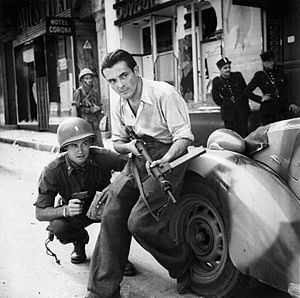
Canadian soldiers in Europe kept extra Stens for special missions. The Sten was even used after World War II. The British Royal Navy used them into the 1960s. They were also used in the Korean War. The Sten was slowly replaced by the Sterling SMG in the British Army in the 1960s.
The Sten was one of the few weapons that Israel could make themselves during the 1948 Arab–Israeli War. Even before Israel became a country, people were making Stens for defense. After Israel was formed, they kept making Stens for their army. The other side in the conflict also used Stens, mostly British-made ones.
In the 1950s, British weapons were given "L numbers." Stens were known as L50 (Mk II), L51 (Mk III), and L52 (Mk V).
One of the last times the Sten was used in British service was during a conflict in Northern Ireland from 1956–1962. In other countries, the Sten was used in combat as recently as the Indo-Pakistani War of 1971.
Sten guns were widely used by fighters during the Bangladesh Liberation War in 1971. In 1975, the President of Bangladesh and his family were killed using Sten guns.
Some silenced Stens were used by US Special Forces during the Vietnam War.
In 1984, the prime minister of India was killed by her bodyguards. One of them fired his entire Sten magazine at her.
During the Second Sino-Japanese War and the Chinese Civil War, both Chinese forces used the Sten. Some Stens were changed by the communists to use 7.62mm bullets. British, Canadian, and Chinese Stens were seen in the hands of communist forces during the Korean and Vietnam Wars.
The Finnish Army bought many Stens in the late 1950s. They were mostly kept in storage for future use.
In 1994, during the Zapatista movement in Mexico, some Zapatista soldiers were armed with Sten guns.
Who Used the Sten Gun
 Albania
Albania FNLA
FNLA Argentina
Argentina Australia
Australia Bangladesh
Bangladesh Botswana
Botswana Belgium
Belgium British Hong Kong
British Hong Kong Canada
Canada Central African Republic
Central African Republic Ceylon
Ceylon Republic of the Congo (Léopoldville)
Republic of the Congo (Léopoldville)
 Katanga
Katanga
 Cuba
Cuba Cyprus
Cyprus People's Republic of China
People's Republic of China Republic of China
Republic of China Czechoslovakia
Czechoslovakia Denmark
Denmark Egypt
Egypt Finland
Finland France
France Greece
Greece Grenada
Grenada India
India Indonesia
Indonesia Israel
Israel Italy
Italy Empire of Japan
Empire of Japan Jordan
Jordan Kenya
Kenya Kingdom of Laos
Kingdom of Laos Libya
Libya Luxembourg
Luxembourg Malaysia
Malaysia Malta
Malta Myanmar
Myanmar Nepal
Nepal Netherlands
Netherlands Nazi Germany
Nazi Germany New Zealand
New Zealand Nigeria
Nigeria North Korea
North Korea Norway
Norway Pakistan
Pakistan Philippines
Philippines Poland
Poland Portugal
Portugal Rhodesia
Rhodesia Sierra Leone
Sierra Leone South Africa
South Africa
 South Vietnam
South Vietnam Thailand
Thailand Tibet
Tibet Turkey
Turkey United Kingdom
United Kingdom United States
United States North Vietnam
North Vietnam Yugoslavia
Yugoslavia
Other Groups
- The Provisional IRA and Official IRA
- The Ulster Volunteer Force and Ulster Freedom Fighters
- Balcombe Street Gang
- The Angry Brigade
- Some were supplied to the Bulgarian Communist Party during WWII
Images for kids
-
The "Monumento al Partigiano" in Parma, Italy, shows an Italian partisan holding a Sten.


